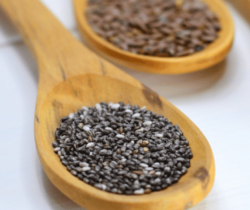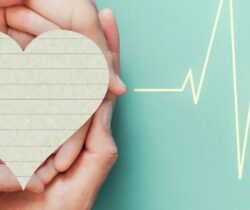Heart disease is a term that generally refers to any condition that affects the cardiovascular system—that’s the heart, blood vessels and blood.
Heart disease is a massive problem globally. In Australia, it kills one person every 18 minutes and is responsible for almost 20% of all deaths. It kills more men each year here than prostate cancer, suicide, bowel cancer and road accidents combined.
So, it’s something we all need to know about.
In this article we’ll describe what its early symptoms are, with a focus on how they show up in men. We’ll also tell you what to do if you spot them.
Understanding the heart
The heart is a muscle that’s about the size of your fist. It pumps blood and is the main organ in the circulatory system, which also includes blood and blood vessels such as arteries, veins and capillaries. Blood is composed of red and white blood cells, plasma and platelets.
The heart has four chambers that are powered by electrical impulses and controlled by your brain and nervous system. Its main function is to circulate blood throughout the body to deliver oxygen, nutrients and hormones to muscles, tissues and organs. The heart also regulates the rhythm and speed of the heartbeat and helps maintain blood pressure.
Types of heart disease symptoms
Coronary heart disease (CHD), also known as coronary artery disease (CAD), is caused by a build-up of cholesterol (atherosclerosis) or inflammation in the blood vessels. Its main warning signs and symptoms are:
- chest pain
- shortness of breath
- feeling of nausea
- sweating
- quickening heartbeat
- fatigue and dizziness.
Arrhythmias are abnormalities of the heart’s rhythm. It may beat too slowly, too quickly or irregularly. Its common signs and symptoms are:
- palpitations
- chest pain or discomfort
- fatigue and dizziness
- shortness of breath
- feeling unwell
- sweating
- anxiety
- fainting or nearly fainting.
A congenital heart defect is a problem with the structure of the heart that is diagnosed from birth. Serious congenital heart defects usually are noticed soon after birth or during the first few months of life. Common signs and symptoms include:
- pale grey or blue lips, tongue or fingernails (cyanosis)
- rapid breathing
- swelling in the legs, belly or areas around the eyes
- shortness of breath during feedings, leading to poor weight gain.
Cardiomyopathy is a disease of the heart muscle that makes it harder for the heart to pump blood. There might be no signs or symptoms in the early stages of cardiomyopathy, but as it advances, warning signs and symptoms usually appear. These include:
- breathlessness, even at rest
- swelling of the legs, ankles and feet
- bloating of the abdomen due to fluid build-up
- coughing while lying down
- rapid, pounding or fluttering heartbeat
- chest discomfort
- fatigue and dizziness, lightheadedness and fainting.
Heart valve disease is where one or more of the valves in your heart doesn’t work properly. Its common signs and symptoms are:
- chest pain
- abdominal swelling
- tiredness
- shortness of breath
- swollen ankles and feet
- dizziness
- fainting
- irregular heartbeat.
Diagnosis and testing: identifying heart disease through medical examinations and procedures
There are several tests and procedures that diagnose heart disease. The main ones are:
- blood tests
- chest X-ray
- electrocardiogram (ECG or EKG)—records the electrical activity of the heart
- Holter monitoring—a Holter monitor is a device that can be worn and that detects irregular heartbeats (arrhythmias)
- echocardiogram—uses sound waves to show if blood is flowing through the heart properly
- stress tests—shows how the heart works when you’re doing exercise
- cardiac catheterisation—a flexible tube is fed into a cardiac blood vessel to detect clogged arteries or arrhythmias
- heart (cardiac) CT scan—a dye is injected into the blood and then a scanner shows its passage through the blood vessels and heart
- heart (cardiac) magnetic resonance imaging (MRI) scan—uses radio waves to check the structure and function of the heart.
When to see a doctor
If you have any of the above signs or symptoms, especially chest pain, worsening breathlessness or palpitations, it is important to have them checked out by a doctor.
If you are unsure whether or not an ambulance is needed, call emergency services and let them decide.
Risk factors for heart disease
The common risk factors for heart disease include:
- smoking
- being overweight
- inactivity
- high blood pressure
- family history
- age
- cholesterol
- high blood sugar
- stress
- poor diet
- alcohol intake.
Age, gender, family history and lifestyle choices are all factors that can affect heart disease risk. Older people are more likely to suffer from heart disease than younger people. Women have some protection against coronary artery disease before menopause due to the hormone oestrogen, but they are more likely to die within a year of having a heart attack than men. Having a family history of early heart attack or a heart attack before age 50 increases your risk of heart attack and stroke. People who maintain a healthy weight, exercise regularly and eat a healthy diet can lower their risk of heart disease by nearly 50%.
Common signs of heart attack and stroke
Common warning signs and symptoms of heart attack include:
- pain or discomfort in the chest region
- pressure or tightness in the chest
- pain or discomfort in the arm, back or neck region (usually on the left side)
- excessive sweating
- shortness of breath
- feeling of nausea
- vomiting
- dizziness.
Common signs or symptoms of stroke include:
- paralysis or numbness or inability to move parts of the face, arm or leg—particularly on one side of the body
- confusion
- trouble speaking
- headache with vomiting
- trouble walking.
You should call emergency services immediately if you or someone else may be having a heart attack or stroke.
Signs and symptoms of heart disease in men
Men may experience a variety of symptoms of heart disease. These include chest pain, breathlessness and pain or tingling in the arms, back or neck. Other symptoms can include dizziness, fainting, a feeling of irregular heartbeat.
Diagnosis and treatment of heart disease
Heart disease is diagnosed using a variety of tests. Your doctor will start by taking your personal and family medical history, recording any symptoms you’ve experienced and doing laboratory tests and an electrocardiogram (ECG or EKG). Depending on the results, the doctor may order further tests.
Complications of heart disease
Heart disease can cause many serious complications. These include heart failure, heart attack, stroke, pulmonary embolism, cardiac arrest, peripheral artery disease (PAD) atrial fibrillation and angina.
The complications of heart disease can be prevented or managed through a combination of lifestyle changes, medications and medical procedures. Lifestyle changes such as eating a healthy diet, exercising regularly, maintaining a healthy weight and managing stress can help. Medications may be prescribed and, in some cases, medical procedures may be necessary.
Treatment options: medications, surgeries and lifestyle changes for managing heart disease
Healthy lifestyle habits such as eating well, getting enough exercise and sleep and not smoking are vital in treating heart disease. However, if lifestyle changes alone don’t work, medication may be required. The type of medication that’s prescribed depends on the type of heart disease. Some people with heart disease may need to have surgery. Again, the type of surgery will depend on the type of heart disease, but two procedures that are commonly carried out are coronary artery bypass grafting (CABG), which is used to treat severe coronary heart disease, and heart valve repair or replacement.
Exercise and physical activity: the importance of exercise in preventing and managing heart disease
Exercise has many beneficial effects for preventing and managing heart disease. It can lower blood pressure, increase ‘good’ HDL cholesterol and reduce ‘bad’ LDL cholesterol, improve circulation, reduce inflammation and use up calories. Physical activity also strengthens the heart, reduces stress hormones and helps control blood sugar. Happily, you don’t have to reach Olympic standards to do yourself good: walking fast enough to get your heart rate up, for example, is excellent exercise for cardiac health.
Conclusion
The prevalence of heart disease, and men’s increased risk of heart disease, underline the importance of preventing it.
Quitting smoking, maintaining a healthy weight, being more active and eating nutritious food can all help to improve the management of diabetes and heart health.
But successfully making long-term healthy lifestyle changes is not always easy. This is where prevention programs such as Life! can help.
How the Life! program can help you
Life! is a free healthy lifestyle program that helps you improve your eating habits, increase your physical activity and manage stress. It will help you reduce your risk of developing diabetes, heart disease and stroke.
Life! is run by experienced health professionals, including dietitians and exercise physiologists, who guide and support you to make healthy lifestyle changes.
The program includes 7 sessions delivered over a 12-month period. You can choose from a group course or our telephone health coaching service. Learn more about the program at www.lifeprogram.org.au
You can also check your eligibility for the program by taking a quick online test here.
Sources
https://pubmed.ncbi.nlm.nih.gov/10863872/
https://pubmed.ncbi.nlm.nih.gov/27029220/
https://www.betterhealth.vic.gov.au/health/conditionsandtreatments/heart-disease-risk-factors
https://www.cdc.gov/heartdisease/any_age.htm
https://www.health.harvard.edu/heart-health/gender-matters-heart-disease-risk-in-women
https://www.healthdirect.gov.au/coronary-heart-disease-and-atherosclerosis
https://www.healthdirect.gov.au/heart-attack
https://www.healthdirect.gov.au/heart-attack-symptoms-men-vs-women
https://www.healthdirect.gov.au/heart-failure
https://www.healthdirect.gov.au/stroke
https://www.healthline.com/health/heart-disease/complications
https://www.heartfoundation.org.nz/your-heart/how-the-heart-works
https://www.mayoclinic.org/diseases-conditions/heart-valve-disease/symptoms-causes/syc-20353727
https://www.medicalnewstoday.com/articles/cardiovascular-system
https://www.msn.com/en-us/health/condition/Stroke/hp-Stroke
https://www.nhlbi.nih.gov/health/coronary-heart-disease/women
https://www.nhlbi.nih.gov/health/heart-attack
https://www.nhs.uk/conditions/arrhythmia/
https://www.nhs.uk/conditions/coronary-heart-disease/
https://www.nhs.uk/nhs-services/urgent-and-emergency-care-services/when-to-call-999/
https://www.nia.nih.gov/health/heart-health-and-aging
https://www.sciencedirect.com/science/article/pii/S2590093519300256
https://www.verywellhealth.com/heart-disease-men-vs-women-4126017
https://www.webmd.com/heart-disease/heart-disease-men
https://www1.racgp.org.au/newsgp/clinical/women-less-likely-to-have-heart-disease-and-die-fr
Reviewers
Kristie Cocotis, Head of Prevention and Health Promotion
Sarah Dubé, Strategy and Engagement Lead
Ria Cheripuram, Digital Communications Officer
Tegan Kohlman, Communications and Social Marketing Officer
Iftu Umar, Program facilitator and Health Coach






